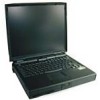Dell Inspiron 7000 Dell Inspiron 7000 Reference and Troubleshooting Guide - Page 95
Xewhvwv
 |
View all Dell Inspiron 7000 manuals
Add to My Manuals
Save this manual to your list of manuals |
Page 95 highlights
that the software is functioning properly by moving it to another computer and running it there.) The computer periodically locks up (becomes unusable and must be rebooted), especially at different places and times in different programs. Three subtests are available for RAM: the Quick Test, the Comprehensive Test and the Cache RAM Test. The Quick Test performs an address check to determine whether the computer is properly setting and clearing individual bits in RAM, and whether the RAM read and write operations are affecting more than one memory address location at one time. This subtest checks all available RAM. The Comprehensive Test also performs an address check, as well as the following checks: Data pattern checks, to look for RAM bits that are stuck high or low, shortcircuited data lines, and some data pattern problems that are internal to the memory chips A parity check that verifies the ability of the memory subsystem to detect errors A refresh check, to verify that the dynamic RAM (DRAM) is being recharged properly The Cache RAM Test checks that the system's cache RAM is functioning properly. The subtests in the System Set test group check the computer's basic system board components and verify their related functions. The System Set subtests double-check many system board components, such as the computer's I/O circuitry, that are tested by other test groups or subtests in the diagnostics. You should run the System Set test group if you are having a problem and cannot isolate the failure or malfunction to a particular system board component. The System Set test group also verifies the proper operation of other computer components, such as the speaker, that are not tested elsewhere in the diagnostics. The following symptoms usually suggest a problem with a component or subassembly that warrants running a System Set subtest: A program is not running as usual, or a proven piece of software appears to malfunction and you confirm that the software itself is not at fault. (You can confirm that the software is functioning properly by moving it to another computer and running it there.) A PC Card you previously accessed can no longer be accessed. The computer periodically locks up, especially at different places and times in different programs. Running the Dell Diagnostics 4-15















